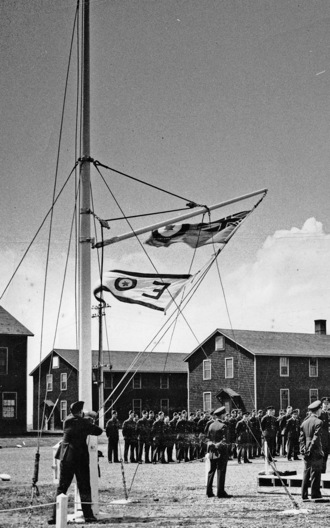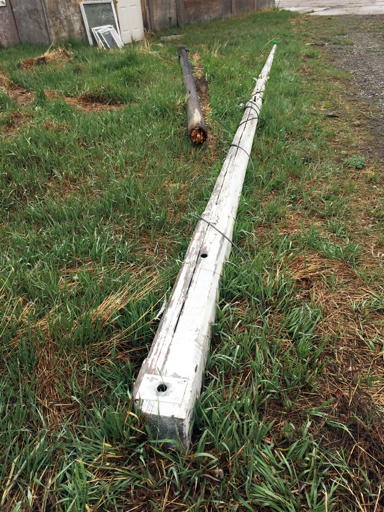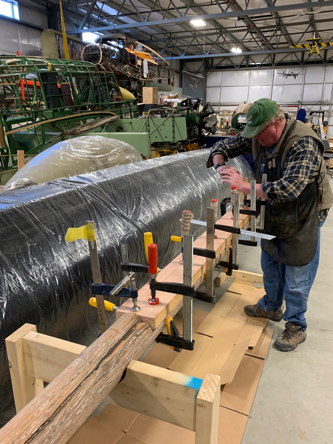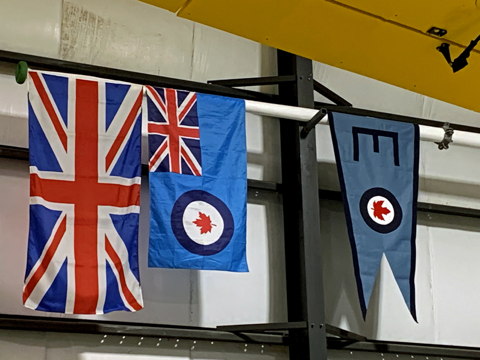 Museum
Museum  |
Bomber Command
|
Aircrew Chronicles
|
Aircrew Losses
|
Nose Art
|
BCATP
|
Lancaster
|
Media
|
Bomber Command
|
Aircrew Chronicles
|
Aircrew Losses
|
Nose Art
|
BCATP
|
Lancaster
|
Media
 Museum
Museum  |
Bomber Command
|
Aircrew Chronicles
|
Aircrew Losses
|
Nose Art
|
BCATP
|
Lancaster
|
Media
|
Bomber Command
|
Aircrew Chronicles
|
Aircrew Losses
|
Nose Art
|
BCATP
|
Lancaster
|
Media
Bomber Command Museum Chronicles
 on the De Winton flagpole on 27 May, 1943. |
As the war intensified and aerodromes in the UK began to be bombed by the enemy, there were concerns that aircrew training would become very difficult in the U.K. and so began the transfer of some of the Royal Air Force's flying training schools to Canada. One of these RAF operated schools was No. 31 Elementary Flying Training School that began operations on June 18th 1941, just south and a little east of Calgary. The airfield had the usual BCATP triangular runways arrangement, two hangars, and the usual H-Hut barracks, mess halls, and other BCATP base support buildings. Grass runways at Gladys and asphalt runways at Shepard were used as auxiliary landing facilities. Like most EFTS's, De Winton began its operations with the Canadian-built Tiger Moth aircraft but during the summer of 1942, the Boeing Stearmans that formerly operated at No. 36 EFTS arrived from Pearce. Aviation historian Tim Johnston first noticed the flagpole while walking through the site in 2015, prior to spearheading a group (that included the Bomber Command Museum of Canada) that went on to place a roadside memorial plaque at what was formerly the entrance to the station. The gun-butts and camp guard-house at the school's entrance were the only structures that remained, but Tim walked across portions of the runways and the concrete floors and foundations of the hangars and other buildings. Amongst all this, a portion of a round piece of wood caught Tim's eye through the tall grass. As he brushed away more of the grass to expose its full length and three large clamps, it became obvious that this could only be RAF De Winton's flagpole -simply the thirty-three foot long trunk of a Douglas Fir, painted white. |
Tim recalled having seen the flagpole as the focal point in a photo of station personnel assembled on 31 EFTS's parade square as officers proudly raised an 'Efficiency Pennant' on 27 May 1943. It was a very special day for the school as their School was being recognized as one of the very best in the British Commonwealth Air Training Plan. There it was, almost completely hidden in the tall grass and rotting away. Tim advised the museum of his discovery and it was obvious that this flagpole should be recovered, restored, and placed in the museum. Arrangements were made with the owner of the property, who was pleased to donate the flagpole to the museum. Noting that a significant section in the centre portion of the flagpole had rotted away, care was taken as it was placed on a trailer and delivered to the museum. |
 |
 |
Over the next several months, museum volunteers sanded off what remained of the original paint, carefully removed the rotted-out area and replaced it with new Douglas Fir, filled several large, long cracks, and painted the pole a glossy white as it had been during the war at 31 EFTS De Winton. One significant problem remains. It was hoped to stand the flagpole at the highest point of the museum's main hangar but it turns out that the flagpole is a little too tall for that. So the De Winton flagpole, now fully-restored, rests horizontally on racks against the west wall of the museum, awaiting the construction of our new hangar which, we hope, will be high enough to display 31 EFTS's centrepiece in its proper configuration with a Union Jack at the top and an RCAF flag from its arm. As well, a replica of that Efficiency Pennant will be there.  The restored De Winton flagpole -on display and awaiting a higher hangar so that it can again be vertical. |